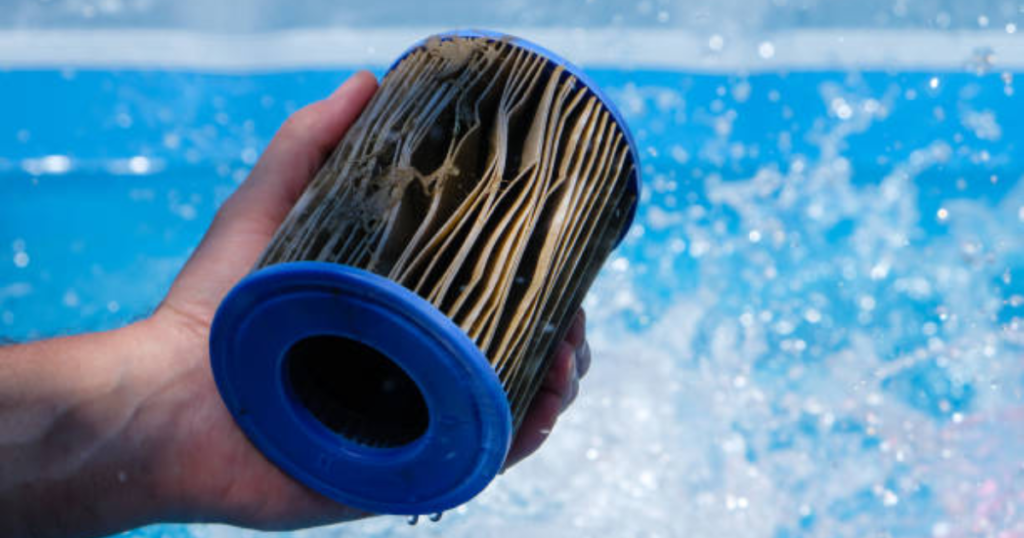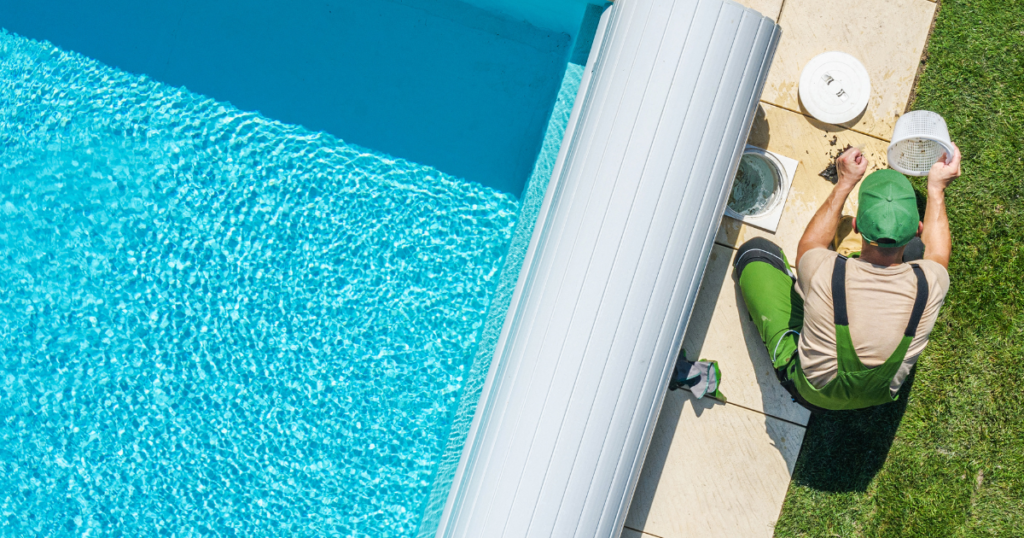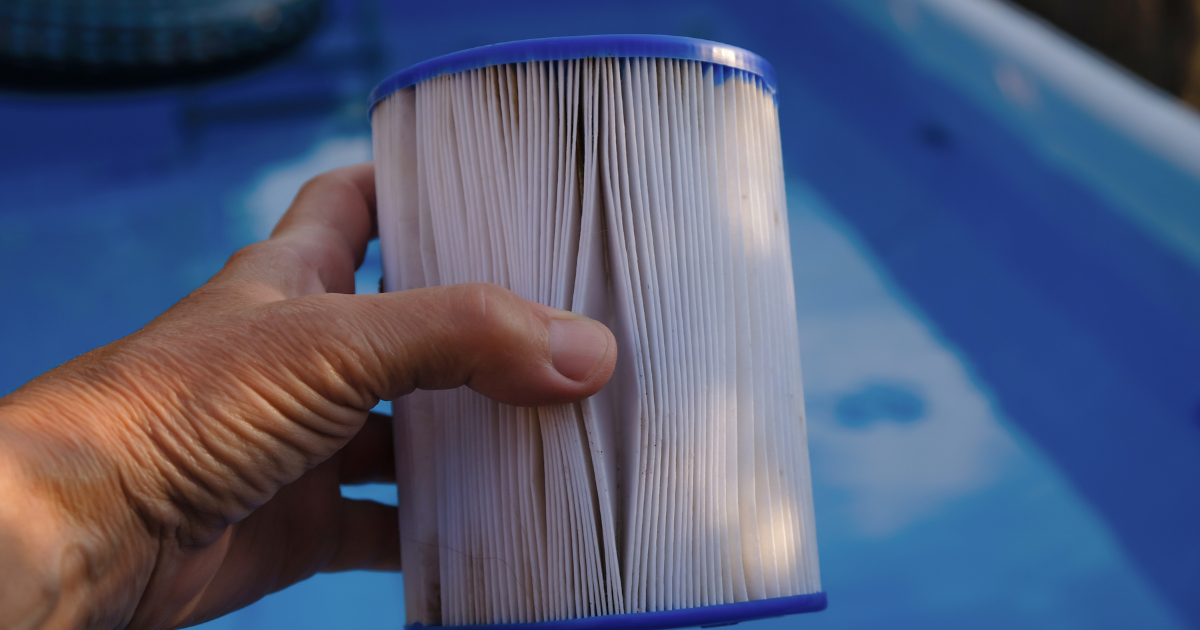Do you believe your pool is clean? You may want to think again. According to CDC data, many pools are full of bacteria–including fecal matter. During a routine inspection in 2013, nearly 80 percent of 48,632 public water venues were found to have at least one safety violation.
What’s more, a similar study found that 58 percent of tested pool filter samples were positive for E. coli, and 59 percent contained Pseudomonas aeruginosa. E. coli is a type of bacteria found in the human intestines, and you guessed it, poop.
Unless you enjoy swimming in dangerous bacteria, changing your pool filter is essential to enjoying a cleaner and healthier swimming experience for you and your family. So, the common question is: How often should you change your pool filter? Another common question is does a pool filter provide any other benefits besides just filtering? To help keep your pool clean, let’s break down the whys, whens, and hows of changing your pool filter cartridges. Let’s get started!
Pool Filter Cartridges
Pool filter cartridges are the filtration part of your pool’s filter system. They insert into the filter itself and catch dirt, grime, bacteria, and more. If your filter is dirty, it’s likely you’re swimming in E. coli or something worse – and it’s not a knock on your pool. Every time someone swims, they are bound to leave dead skin cells in the pool, at the very least, and your filter is your only line of defense. Plus, with a dirty filter, you’re undoubtedly swimming in more contaminated water than if you used no filter at all. It all comes down to how the filter itself functions.
When your pool pump runs, it draws water into the filter system, filters it, and then pumps it back into the pool. If there’s dirt or grime in your filter, those same contaminants don’t get captured and will continually get mixed into your pool’s water. When it’s all said and done, your filter is the difference between a clean pool and a dirty pool.
How to Extend Your Pool Filter Life
While your pool’s filter will wear out eventually, you can take a few steps to increase its lifespan. You need to keep the filter clean. It takes time, but you should wash out your filter cartridge every time you’re done swimming. This means flushing the cartridge with your hose, kitchen faucet, or some other water source. The more often a pool filter is clean, the longer you can wait between changes. However, even if you clean your cartridge every day, environmental factors can thwart your efforts.
For instance, excessive pollen or trees surrounding your pool can cause unavoidable debris in the filter. Some people go as far as waiting to open the pool until after the trees drop their summer seeds.

Signs Your Pool Filter Needs Changing ASAP
Beyond a dirty filter, sometimes your pool filter needs changing right away. In certain circumstances, a bad pool filter can actually pose a significant risk to the other components of your pool. Let’s take a look at a few issues that a bad pool filter could cause.
Pool Filter Problem #1: High PSI
Your pool puts the water under pressure as it moves through the filtration system and eventually back into the pool. If your filtration system cracks a pipe or other part, it may be the result of excessive PSI which is likely due to a dirty filter cartridge. When water can’t easily flow through the cartridge, it forces the pump to work harder and pressure builds. If you notice undue pressure, stop your pool’s filtration system and change your cartridge immediately.
Pool Filter Problem #2: Frayed Fabric
Pool cartridges made from porous fabric allow water to pass through while trapping debris. With time, wear and tear from water pressure and other debris eventually causes the material to fray. Frayed material releases debris into your pool pump, leading to pump breakage, or it simply recycles the dirt particles back into your pool. If your filter looks bumpy, furry, or uneven in any way, replace it as soon as possible.
Pool Filter Problem #3: Crushed Cartridge Cores
Filter cartridges can fail when the inner core collapses on itself. When the plastic reinforcement breaks, the filter resembles something like a crushed soda can. Similar to a frayed filter, the same problems occur with a crushed filter and a new filter is your only option.
Pool Filter Problem #4: End Cap Failure
Every pool filter has plastic caps that help it keep its shape while also locking it in place. And while the caps consist of solid plastic, pool treatment chemicals can eventually make the plastic brittle. Cracking end caps allow the filter to crumble or lose proper positioning, which in turn allows debris through the pump and can also affect the pump system’s water pressure. In addition, pieces of the broken cap can circulate through the pump and damage the entire filtration system.
Pool Filter Problem #5: Normal Pool Filter Wear and Tear
If your pool filter doesn’t suffer from any of the above symptoms, you can wait and change your filter on a set schedule. Most pool filter cartridges are suitable for around 2,000 hours, which is usually around one to two years.
Though filters do wear quicker when exposed to sunscreen, deodorant, hair products, and other chemicals introduced into your pool’s filtration system, your filter replacement schedule also depends on the size of your pool and, therefore, pool pump. The larger your pool, the more water running through your filter, and the quicker it’ll wear and start letting debris into your pool. What’s more, even small pools can burn out filters fairly quickly if enough people consistently swim. Natural body oils alone can build up and clog your filter cartridge.

How to Change Your Pool Filter
Now that we’ve touched on when to change your pool filter, we need to talk about how. After all, knowing when to replace the filter doesn’t do any good if you can’t change it yourself.
Luckily, changing the pool filter is easy.
Step 1: Removing the Pool Filter
Before you can remove the pool filter, you’ll need to turn off the pump system. If you don’t, you’ll spray water everywhere. It’s a mistake most people only make once.
Next, shut off the valves leading into and out of the filter. This stops any extra water from entering the filter while you work. Remove the tubing that connects to both sides of the filter, and you’re ready to remove the cartridge itself.
The actual cartridge should unscrew (or unclip, clamp, etc., depending on the filter’s make and model) from the housing and drain water. Look inside where the filter was and ensure nothing seems broken.
Step 2: Replacing the Pool Filter
The actual replacement process involves screwing the new filter into place. Check with both your pool and filter manuals to make sure you’re installing the filter in the correct orientation.
Once you’ve reviewed the manual, you can plug in the new filter and ensure it’s securely in place.
Step 3: Reconnecting and Restarting Your Pump
Now that the new filter is installed, you can begin reconnecting the pipes to the filter assembly. First, dry-fit the pipes to make sure they all fit back in place. Next, prime the pipe threads, cover them in Teflon tape or pipe sealant, and reconnect all the connections.
Attach the pipe couplings, and you’re ready to start the filter. Ensure the water’s pumping correctly, and you’re ready to swim!
Choosing the Best Pool Filter Replacement
Every pool needs different pool filter cartridges depending on its specific filter assembly, PSI, outflow, and more. You’ll need to consult your manual and current filter to ensure you’re buying the correct filter for your pool. Like a dirty filter, an incorrect fitting filter can cause damage to other parts of your filter assembly. PSI especially can widely fluctuate when you’re using the wrong filter.
Material density and filter fit can let either too much or too little water through the pump. Small filters increase the PSI too much, while large filters decrease the PSI and strain the pump.With an enormous amount of filters on the market, it’s crucial to select not only the correct filter for your pool but also a high-quality filter. The more money you spend on your filter, generally the longer it’ll last.
Other Frequently Asked Questions
How do I know if my pool filter is bad?
Signs that point to a bad pool filter are water that appears dirty, discolored, and gives off an unpleasant smell. Check your pool filter for piled-up dirt and fuzz, as these would indicate that it’s time for a new filter.
Does backwashing a pool clean the filter?
For your pool to run clean and clear, backwashing is recommended. Backwashing is the process of thoroughly cleaning the pool’s (sand or DE) filter media by reversing the flow of water to flush out contaminants from the pool. This process alone does not entirely clean a pool filter, but it does help extend the filter’s lifespan by clearing buildup from it.
What will ruin a pool filter?
Petroleum-based products can destroy both your o-rings and filter and should never be used. Instead, consider lubricants made from either silicon or teflon. Impure Chlorine is another that can ruin your pool filter. Look for chlorine that is at least 96% pure.
What is the best time of the day to run a pool filter?
Running your pump during the hottest parts of the day helps combat the effects of the sun, especially with deterring algae growth and removing bacteria and debris during peak swim times. Splitting up time into shorter intervals and running your pool pump during the morning and evening can help maximize efficiency.

